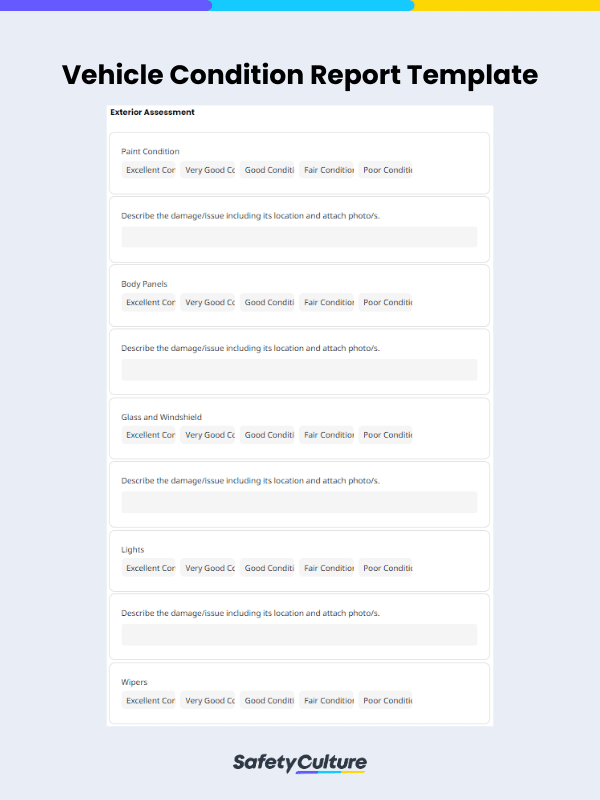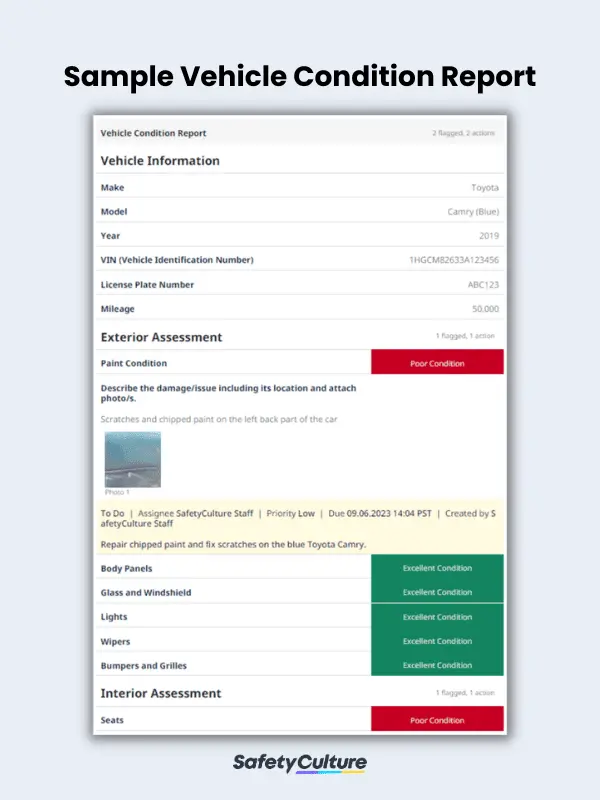What is a Vehicle Condition Report Template?
A vehicle condition report template is a standardized document and tool used to record and state the condition of a vehicle. It provides a structured format to help the individual assessing a vehicle describe its exterior, interior, mechanical components, and any existing damages or issues in detail.
How to Describe Vehicle Condition
When describing a vehicle’s condition, be specific and provide details about its overall aspects, including the exterior, interior, mechanical aspects, and tire condition. Include information about any repairs needed, maintenance history, and the overall impression of the vehicle. With these guidelines, you can accurately assess and describe a vehicle’s condition using the common terms “Excellent,” “Very Good,” “Good,” “Fair,” and “Poor.”
You can use these sample criteria to help you describe a vehicle’s condition:
- Exterior: Minimal or no visible flaws, scratches, or dents
- Interior: No signs of wear or damage, clean and well-maintained.
- Mechanical: All systems and components are in excellent working order, with no issues or repairs needed; the tread depth is good, and the tires are in excellent condition.
- Overall: The vehicle appears almost new and has been meticulously cared for.
- Exterior: Minor cosmetic flaws like light scratches or small dents
- Interior: Minimal wear and tear, clean and well-kept
- Mechanical: All systems and components are in good working order, with no major issues; the tread depth is decent, and the tires are in good condition.
- Overall: The vehicle shows slight signs of use but is in overall great condition.
- Exterior: Visible wear and tear, including scratches, dents, or blemishes
- Interior: Some signs of wear, such as minor stains or wear on upholstery
- Mechanical: All major systems and components are functional, with no significant issues; the tread depth is reasonable, and the tires are in acceptable condition.
- Overall: The vehicle shows average wear and tear for its age and mileage.
- Exterior: Noticeable wear and tear, multiple scratches, dents, or paint damage
- Interior: Moderate wear, such as stains, tears, or significant signs of use
- Mechanical: Some mechanical or electrical issues that require attention, but the vehicle is still operational; the tread depth may be low, and the tires may require replacement soon.
- Overall: The vehicle shows significant signs of use, with noticeable wear and some functional issues.
- Exterior: Extensive damage, including major dents, deep scratches, or severe paint damage
- Interior: Severe wear, significant damage, or non-functional components
- Mechanical: Multiple mechanical or electrical issues that impact the vehicle’s functionality; low tread depth, worn-out tires, or uneven wear.
- Overall: The vehicle is in poor condition, with significant cosmetic and mechanical deficiencies.
Why Use a Template For Recording Vehicle Condition
Having a standardized vehicle condition report template is important to achieve the following benefits and more:
- Ensures that all necessary information is consistently captured for each vehicle assessment
- Saves time and effort by not having to create a format from scratch for each vehicle assessment
- Provides a clear and objective assessment of the vehicle’s condition before and after a specific event, such as a rental period or transport
- Helps protect the interests of both parties involved by documenting any pre-existing damages or issues
- Makes it easier to share information about the vehicle’s condition with relevant parties, such as buyers, sellers, renters, or insurers
- Serves as a reference point or legal document for resolving disputes or claims regarding damages that may occur during the use or transportation of the vehicle
What Should Be Included in a Vehicle Condition Report Template
A comprehensive vehicle condition report template typically includes these key information and sections:
- Title Page – Details about the vehicle assessment and report being created
- Vehicle Information – Make, model, year, VIN (Vehicle Identification Number), license plate number, mileage, etc.
- Exterior Assessment – Any scratches, dents, paint chips, windshield cracks, rust, or other visible damages
- Interior Assessment – Condition of seats, upholstery, dashboard, carpets, and any equipment or accessories
- Mechanical Assessment – Functionality of lights, indicators, brakes, tires, wheels, engine, transmission, etc.
- Additional Details – Fuel level, tire pressure, and existing damages
- Provision for Media Attachments – photos and other visual documentation of the vehicle’s condition and any damages or issues
- Completion Page – Any other relevant observations and sign-offs
How to Write a Vehicle Condition Report Using a Template
To write a vehicle condition report using a template, follow these steps:
- Include information about the vehicle assessment being conducted and the purpose of recording the vehicle’s condition.
- Enter the vehicle information, including the make, model, year, VIN (Vehicle Identification Number), license plate number, and mileage or odometer reading.
- Use the designated sections to describe the condition of the vehicle’s:
- exterior, including the lights, mirrors, windows, and windshields;
- interior, including the seats, upholstery, dashboard, carpets, headliner, air conditioning, infotainment system, and controls;
- mechanical components and systems, including the engine, transmission, brakes, steering, suspension, exhaust, lights, indicators, audio system, and power windows; and
- tires, including tread depth, wheels, and rims.
- Note any scratches, dents, paint chips, rust, stains, wear and tear, abnormal noises, vibrations, leaks, or other visible damages and issues.
- Include any additional observations or details about the vehicle’s condition, such as maintenance records, recent repairs, modifications, or known issues.
- Attach relevant photos and notes to provide context or evidence of the vehicle’s condition.
- Ensure the report is dated and signed by the person conducting the assessment. If applicable, obtain the signature of the vehicle owner or representative as well.
FAQs About Vehicle Condition Report Templates
The most common failures or issues experienced by cars can vary depending on the make, model, age, and maintenance history of the vehicle. However, there are several common failures that many cars may encounter over time, such as:
- Battery failure
- Alternator failure
- Starter motor failure
- Engine overheating
- Transmission issues
- Brake system problems
- Suspension and steering system failures
- Fuel system issues
- Exhaust system failures
Vehicle condition reports can be used by various parties, including:
- Rental car companies – to document the condition of the vehicle before and after a rental period, ensuring that any damages incurred during the rental are properly recorded
- Dealerships – to assess the condition of used vehicles before offering them for sale
- Transport companies – to record the condition of vehicles being transported and to establish responsibility for any damages that may occur during transit
- Individuals – to ensure an accurate record of a vehicle’s condition when buying or selling a used vehicle
- Fleet Departments – to monitor the condition of their assets, their maintenance schedules, and repair history
Vehicle condition reports are not inherently legally binding documents, but they can serve as crucial evidence in case of disputes. Their importance lies in their ability to provide an objective record of the vehicle’s condition, which can support or challenge claims related to damages or issues.
Yes, vehicle condition reports can be used as supporting documentation for insurance claims. When filing a claim for damages, having a vehicle condition report that predates the incident can help establish the pre-existing condition of the vehicle and provide evidence of the damages caused by the incident.



